Alaska Fish & Wildlife News
October 2021
Muskox on the Seward Peninsula
Near Extinction, Recovery and Sharing the Tundra
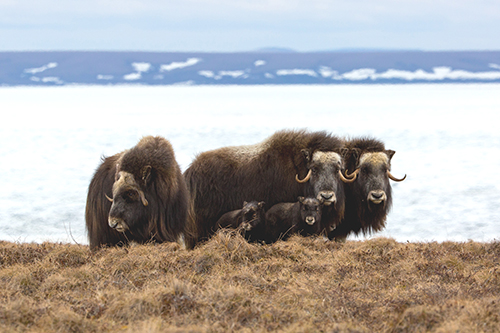
Last month we looked at current muskox research in Alaska. Now we’ll look at where they came from and how we got to where we are today.
In 1970, the University of Alaska published the Inupiat Eskimo Dictionary. Muskox are listed under “Creatures.” Not as “Land Animals,” but as “Animals of History and Legend.” Uminmak (muskox) shares the category with kiligvak (mastodon).
That same year, muskox were introduced to the Seward Peninsula. In the decades that followed, that creature of history became widespread across the Seward Peninsula, numbering in the thousands, with smaller populations (from subsequent transplants) establishing in the Arctic and Southwest Alaska. Their return involved Norwegian sailors-turned-wranglers and an epic 8,000-mile journey from Greenland, remarkable reproduction, some oversights, and diplomacy.
The last muskox
Fossils indicate mammoths, bison and horses were the most abundant large herbivores in ice age Alaska, followed by caribou and muskox. Muskox persisted well after the continental ice sheets receded and until the 19th century, lived across northern Europe, Asia, Greenland and North America. But by the mid-1800s, muskox had disappeared from Europe and Asia. By the turn of the 20th century, muskox were gone from Alaska.
“They only held out in far northeastern Greenland and northern Canada, where people didn’t really have a presence,” said Claudia Ihl, an associate professor of biology at the University of Alaska’s Northwest Campus in Nome. She’s worked with and studied muskox for close to 30 years, writing about ecological, behavioral and cultural aspects as well as biology. Muskox might have already been at low numbers in Alaska by the 1800s, she said.
“They are so easy to hunt, you can walk right up them and kill them,” she said. “When people colonized the arctic, they might have been one of the first animals to be hunted out.”
There are two accounts of what may be the last muskox in Alaska. In the 1912 article “The probable recent extinction of the muskox in Alaska,” in the journal Science, Dr. J.A. Allen writes that Vilhjalmur Stefansson recently returned from a four-year expedition to the Arctic. He interviewed Native Alaskans who related that a man named Mangi, who died in 1900 at Point Barrow, had seen muskox his childhood. Around 1858 Mangi’s father and a hunting party killed 13 muskox on the Kunk (Kuk) River, upriver from Wainwright Inlet. Stefansson wrote, “Since then no one near Point Barrow is known to have killed muskox or seen them.” Stefansson noted that, “There are many places inland from Point Barrow where muskox skulls and bones are abundant.” His expedition acquired one skull.
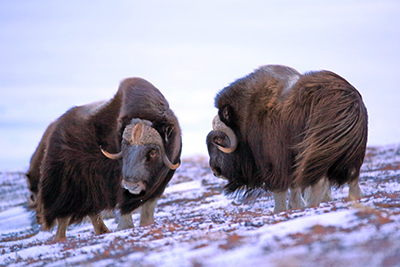
Peter Lent wrote in Muskoxen and Their Hunters, that in 1895 Henry Rapelle visited a Native man living on the bank of the Yukon River who possessed the skull of a muskox. He told Rapelle he thought the muskox was “a bear with horns” when he shot it a year earlier on the Kandik River.
Those locations are 550 miles apart; the Kandik River is east of Fairbanks near the Yukon border, and the Kuk River is southwest of Utqiagvik on Point Barrow.
Records of muskox exploitation in Canada and Greenland by hunters for the Hudson Bay Company document that 23,000 muskox were killed between 1860 and 1915 for their hides. Lent writes that muskox were killed by the thousands for meat and dogfood throughout the arctic by whalers, sealers, explorers, and local hunters. And by the late 1800s, indigenous hunters were far more efficient than their ancestors had been, using firearms and dogs to hunt. Muskox meat supported fox fur farming operations and weather and radio outposts in Canada and Greenland.
The massive decline raised concerns about extinction. In 1917, muskox were protected in Canada, except for some subsistence harvest, and in 1927 Canada established the Thelon Wildlife Sanctuary, the country’s largest wildlife refuge, to conserve muskox. That same year, the Alaska Territorial Legislature urged congress to appropriate money to obtain muskox. In 1930, congress gave the U.S. Biological Survey $40,000 “to acquire a herd of muskoxen for introduction into Alaska with a view to their domestication and utilization in the Territory.”
The comeback kids
That acquisition was remarkably prompt. That summer Norwegian sailors roped and trussed 19 female and 15 male muskox in East Greenland, targeting calves and yearlings which were easiest to manage. They brought them to Norway and then across the Atlantic by steamship. By September they were in New Jersey for a month-long quarantine. A 2,500-mile cross country train trip in October brought them to Seattle; the muskox then took a seven-day voyage by steamship to Seward. The Alaska Railroad transported them to Fairbanks. On Nov. 5, 1930, all 34 arrived at the Alaska Agricultural College and School of Mines, now the University of Alaska.
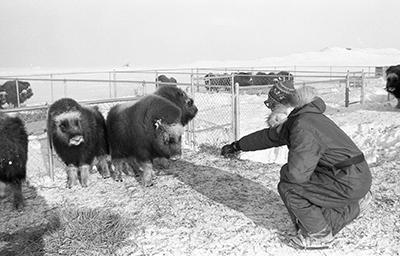
Conditions were not ideal - this was a clearing in the boreal forest, not tundra. The cost of feeding and maintaining the muskox was greater than expected: fencing was inadequate – muskox broke out and bears broke in, killing some animals – and over time better accommodations were sought and found on windswept Nunivak Island, west of Bethel in the Bering Sea. Four animals were delivered in a test run in 1935; in the summer of 1936 a steamship brought the remaining 27 muskox, which included some calves born in captivity, down the Tanana and Yukon Rivers to the coast. A leaky barge took them across 20 miles of choppy seas to Nunivak Island. The population gradually grew and by 1965 there were more than 500 muskox – the source population for future transplants. Hunting began in 1975.
In 1967 a collaboration of state and federal biologists, land managers, and Nunivak Island residents created a program for transplanting muskox. That year, eight muskox were transplanted to nearby Nelson Island, and year later 15 more joined that herd. In 1969-70, 64 were introduced to the Arctic National Wildlife Refuge. In two separate transplants in the 1970s, 70 muskox were transplanted to Cape Thompson in Northwest Alaska. Today, close to 4,000 muskox live in Alaska.
The Seward Peninsula
In 1970, 36 muskox from Nunivak were flown to the Feather River area in the southwest Seward Peninsula about 25 miles from Nome. The population was boosted in 1981 when 35 more were brought to Black Mountain in the same area. Reproduction was robust and the population grew 14 percent annually from 1970 to 2000, and six percent annually between 2000 and 2010. In 1988 the Seward Peninsula census counted 527 animals; in 1998 it had grown to 1,432. In 2005 it had grown to 2,387, comparable to current numbers. Muskox expanded their range eastward across the peninsula and onto the mainland. It’s a biological success, but there were (and are) mixed feelings about these shaggy beasts proliferating on the peninsula.
In those early transplanting days, state and federal agencies sometimes failed to consult (or even inform) local people, who were unprepared for what came. Lessons learned from those oversights have improved more recent efforts such as the wood bison re-introduction. Wildlife biologist Kate Persons moved to Nome in 1995 and served as the area biologist from 1997 to 2007. She’s still in Nome and recalled some of the issues and solutions.
“Part of the problem with lack of acceptance was people didn’t have traditional knowledge of muskox, and all of a sudden these big animals appeared on the landscape,” she said. “Some people didn’t even know what they were. It took a while for people to learn how to make use of these animals.”
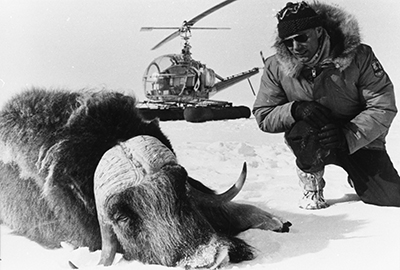
People were concerned that muskox could be dangerous. The Seward Peninsula had domestic reindeer herds, and herders were concerned that muskox would compete with reindeer. In some communities, including Nome, herds moved through cemeteries using the grave markers as scratching posts, knocking them over. Single bulls sometimes hung around remote camps in summer, intimidating to people who were unnerved by their close proximity and unwillingness to leave.
“They have behaviors that are very annoying to the local people in surrounding villages,” Persons said. “Most animals when you approach will flee, but their defense is to hold their ground. If they were in someone’s traditional berry picking or sour dock patch, they wouldn’t move - and the ground would be fouled. They weren’t appreciated. For a long time, they couldn’t hunt them, and then even when they could it was a convoluted process.”
In the mid-1990s when wildlife managers determined the population had grown enough to accommodate some hunting, there were conflicts regarding state and federal administration and who could hunt.
“When I stepped into this, the hunt was on federal lands only,” Persons said. “The state had just authorized some kind of hunt, but the federal subsistence board reacted to that. So, the feds took the entire harvestable surplus for the hunts for federal land, and the state hunt was cancelled before it ever happened. It was big project trying to get all the players to work together to get a plan to provide opportunity for all the muskox interest groups.”
Those hunts on the peninsula were subsistence hunts and required destruction of the trophy (skulls and horns) – this is still required in state hunts on the Seward Peninsula (but not on Nunivak and Nelson islands). Today, state biologists work closely with the National Park Service and the Bureau of Land Management to manage muskox on the Seward Peninsula. Federal mangers on federal public land do not require trophy destruction.
Persons said there was demand from all over the state to hunt muskox, and there were people who wanted accessible areas without hunting, designated for wildlife viewing.
“There were people from the tourism industry that wanted them protected so people could see them,” Persons said. “People had strong interests and sometimes strongly opposing interests.”
Catching on to muskox
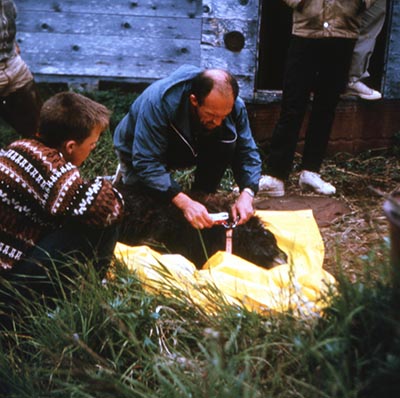
One effort that helped was the formation in 1995 of the Seward Peninsula Muskox Cooperators group, to provide unified recommendations to both the (state) Board of Game and the Federal Subsistence Board. It took a few years for the group to get up to speed. Persons said State Wildlife Planner Randy Rogers was instrumental. Based in Fairbanks, Rogers was also a key player in the wood bison re-introduction process.
“Randy Rogers came to Nome and facilitated our Seward Peninsula Muskox Cooperators group,” she said. “He just connected with people here. He was awesome, I attribute a lot of the success to his ability. Those were complex meetings with a lot of interest groups. He really knew how to run a meeting, and was very comfortable dealing with the kind of issues and people. He made people feel like their ideas were important.”
Management was also something of a moving target. Muskox numbers were growing, and they were ranging into new areas. Wildlife managers tried to accommodate new opportunities. Harvest levels adjusted as biologists learned more about the effects of harvest on growth and the ratio of bulls to cows in the population.
“There was a progression of state hunts,” Persons said. “It was a long process with frequent changes that tried to make it easier and more available while still protecting sustainability.”
Bulls were the focus of harvest, sparing cows for reproduction. Since both genders have horns, hunters favored the biggest animals, which were likely (but not always) bulls, and sometimes older animals with tough meat. An animal behaving like a rutting bull offered a promising target, but bulls in rut don’t always taste good.
Claudia Ihl interviewed hunters across the region in 2009 regarding muskox attitudes. She said people on Nunivak Island benefited from their much longer experience with muskox. They favor eating young animals and cows, which are legal to hunt there.
“Our hunters were still catching on,” she said. “Some families liked them and wanted one every year. Some hunters had one and didn’t like it and said, ‘I’ll never eat one again.”
Bill Dunker, the Seward Peninsula area biologist based in Nome, said hunters went through a learning curve - and are still learning. “People have been hunting caribou for thousands of years, with knowledge passed down generation to generation,” he said. “We’ve been hunting muskox on the Seward Peninsula for 20 years, and there wasn’t even pre-existing traditional knowledge.”
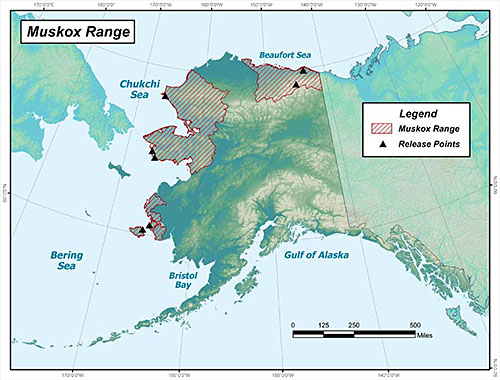
Muskox season is August through March in some areas, and January through March in others. Dunker said the meat of an animal butchered in February (when it may be 30 degrees below zero on the tundra) can be affected by the extreme cold. Freezing quickly (before meat has gone through rigor process or any aging) can result in tougher meat. He’s a hunter himself and said he hears a wide range of opinions from local hunters regarding meat care.
Biologists also had a learning curve. Muskox are not a well-researched species like caribou or moose, and they’re unique in many respects.
“We did not have a playbook for managing muskox,” he said. “If we have a wildlife question, somebody has answered it somewhere – reproduction rates, survival rates, carrying capacity… in several instances we tried to apply moose management principles to muskox and they just don’t fit. We’ve had to build the playbook as we go.”
Management is complicated even within Alaska. Muskox on the Seward Peninsula (and in the arctic) face predators, which muskox on Nunivak and Nelson Islands do not. Habitat and especially winter conditions vary and make a significant difference.
Muskox are built for cold, windy places. They have short legs and incredibly warm coats, and compact bodies which efficiently maintain the core temperature. They don’t migrate but hunker down where they can access food in winter. Caribou, by contrast, move great distances, have long legs and can “crater down” into deep snow to access food.
“Mukox don’t crater well, but they are very well adapted for the cold and for energy conservation. That’s their bread and butter,” Dunker said. “There are windy areas in Western Alaska; Nunivak and Nelson Island are wind scoured and muskox can access feed in the winter months.”
That varies on the Seward Peninsula. Winter habitat for muskox there is very dependent on snow conditions, which are highly variable year to year and month to month. “Snowfall, snow depth, wind and its influence, those variables are dynamic,” Dunker said. “We can easily identify vegetation types in an area, or elevation, but snow conditions and wind are much more dynamic and variable.”

Looking at muskox’ overall life strategy offers insights, he said. They are long lived relative to moose and caribou and a cow has many opportunities to reproduce. Although they just have one calf each year, they have very high pregnancy rates. There’s a good deal of mortality in the first weeks of life for a variety of reasons including predation, but once a calf hits six months of age its odds improve considerably, and then at a year survival rate is comparable to adults.
In 2017 a full-time muskox research biologist position was established, based in Nome, and wildlife biologist Brynn Parr was hired.
Humans weren’t the only hunters learning about muskox
Persons said it seemed to take a while for bears to figure out how to prey on muskox. The stand-your-ground defense worked well, but bears learned muskox could be intimidated into running.
“A hunter witnessed a bear charging into a herd and killing a couple young muskox,” she said. People in Teller observed this head-on bear attack strategy as well in herds close to that community north of Nome. “It was something they hadn’t seen before.”
“I was never aware of wolf predation,” she said. “There was a period when the Western Arctic Caribou Herd wintered on Seward Peninsula and with them came wolves, and I remember some miners telling me about wolves at least harassing muskox, I’m not certain they ever witnessed a kill, but there were wolf-muskox interactions.”
Muskox research biologist Brynn Parr said bears are the main predators of muskox on the Seward Peninsula, and as of 2021 she has not documented wolf predation.
Reindeer and muskox
Claudia Ihl did her masters work in the 1990s on winter foraging behavior of muskox and reindeer and caribou. She said they favor different habitats and deal differently with snow conditions. “There’s a little bit of overlap, but they go to different places and more or less ignore each other,” she said.
She recalled the winter when the Western Arctic Caribou Herd came onto the Seward Peninsula. “The reindeer up and left with them,” she said. “After that, no one heard any complaints about the muskox in that regard. They had been worried about the wrong ungulate.”
Dunker said there were 15 permitted reindeer grazing areas on the Seward Peninsula prior to the intermingling, only four active herding operations remain.
Non-consumptive uses – viewing and qiviut

As the animals became established, wildlife viewers found muskox were cooperative. Persons said they favor nutritious, successional stage plants that thrive on disturbed ground – habitat people create – and that draws muskox right into town. Extensive mining activity around Nome also created that successional habitat. Muskox frequent the hills near town where people recreate. Persons said muskox are “very lackadaisical about people,” which makes them easy to watch.
Wildlife viewing and birding is popular on the Seward Peninsula, with 250 miles of roads providing good seasonal access. Muskox are pretty easy to find. Fish and Game has published two guides, one features hunting and viewing muskox and one highlights wildlife viewing opportunities along the Nome area road system (see link at end).
“They are valued as a viewing resource for sure,” Dunker said. “You can drive a rental car down the road system and see muskox in the wild. It’s an opportunity that’s relatively unique in the state.”
In summer muskox are drawn to shallow creeks and rivers. “They love the water,” Persons said. “They’re not great swimmers, they get really waterlogged with all that hair. But they wade, and they splash and play. The young really frolic, it’s pretty fun to watch.”
All that hair provides another benefit – qiviut, the fine, soft, fur under the long guard hairs, shed every spring. Far warmer than sheep wool, qiviut is a prized resource and a valuable commodity. Claudia Ihl said people of Mekoryuk on Nunivak Island have long gathered qiviut and combed it from hides.
“The use of qiviut is a big deal,” she said. “They get every last scrap of it off of the hides. They spin it themselves, and make scarves and hats for their own use. One thing you notice when you get off the plane in Mekoryuk, everyone wears qiviut. Hats, scarves, sweaters, gloves, baby sweaters. They also sell it for real money, several hundred bucks for each hide.”
Qiviut is also appreciated on the Seward Peninsula. Shed qiviut is collected in the wild, but it needs to be fresh. “Going and collecting muskox wool in the bushes is a thing here in Nome, in late May and June,” Ihl said. “But it’s labor intensive, hiking through willow thickets. You’ll find big sheets of it hanging in the bushes, but you need to get it before it gets rained on.”

See the companion article next month for more on qiviut and raising captive muskox.
What’s next?
On the Seward Peninsula, muskox are continuing to expand their range and have recently moved into the Nulato Hills on the mainland. “People are starting to see them south of the Unalakleet River, for the first time that I can recall,” Dunker said. That’s the southern portion of Game Management Unit 22A, between Norton Sound and the Yukon River. “This is first year we’ve had hunting in Nulato Hills in GMU 22A, so we’ll likely see an uptick in harvest. We’ve added some of the expanded range into the harvest.”
Dunker said currently 25 to 30 animals per year are harvested from the Seward Peninsula population.
The population estimate was about 2,900 in 2010 and dropped to about 2,200 the next year. Dunker said managers adopted a more conservative harvest strategy since that decline was detected. The objective for harvest is at or below 2% of the overall population, and no more than 10% of mature bulls in population, to maintain a ratio of 40 bulls to every 100 cows.
In the early 2000s wildlife managers saw a significant decline in the bull/cow ratio. Prior to hunting the ratio was 40-50 bulls to 100 cows, after ten years of hunting that dropped to 20-25 bulls/100 cows. “That corresponded with some observed declines in recruitment, and increases in cow mortality, and we thought best to manage more closely,” Dunker said. “A big bull plays an important role in defensive actions. So maybe (reducing the ratio) is not a good idea because of the social role they fill, protecting the herd from predators, in addition to their role in breeding.”
“People think these herds are distinct groups of individuals, but there’s a lot of exchange between groups of muskox, especially in the fall,” he added.
Reducing the harvest rate has resulted in a bull-cow ratio increase, and the population is back to 40 bulls/100 cows. Biologists are also seeing more calves survive their first year and join the overall population.
“Last year was a bumper crop in comparison to years gone by,” Dunker said. “We had 19 percent recruitment. The lowest we’ve seen in the past ten years was nine percent in 2015; the average is about 14 percent, then last year it picked up.”
Muskox are no longer on the brink of extinction; Canada has about 85,000 animals, mostly on Banks and Victoria islands in the Arctic, and north of Great Bear Lake. Muskox still roam eastern Greenland and were re-introduced to western Greenland. Muskox from Nunivak were introduced to Russia’s Wrangell Island in the 1970s, and to the Tamayr Peninsula, and are established (Russia's population estimate was 8,000 in 2008). A 2019 paper on muskox status in the journal Ambio estimates a global population of 170,000 - acknowledging some uncertainty.

The introduction of fewer than three dozen muskox to the southwest edge of the Seward Peninsula 51 years ago proved to be a biological success story. More than two thousand muskox roam the region today, and their range continues to expand.
“Time will tell what areas they will thrive in,” Dunker said. “As they get into more interior portions of the state, near the Yukon River, there is more deep snow and less wind, which is not good for muskox. Cold is good. Wind scoured ridgetops are good.”
Kate Persons has seen the numbers more than double in her time in Nome. “The expansion was amazing to see, it was very exciting,” she said. “It’s a cool thing that was done here.”
More on muskox
Downloadable PDF Muskox Hunting, Viewing, and Identification Guide
Alaska’s Nome Area Wildlife Viewing Guide
Nome and the Seward Peninsula Wildlife Viewing website:
http://www.adfg.alaska.gov/index.cfm%3Fadfg%3Dviewinglocations.sewardpeninsula
Mind your muskox manners coloring page, downloadable PDF: Mind Your Muskox Manners: Coloring Page
Subscribe to be notified about new issues
Receive a monthly notice about new issues and articles.
